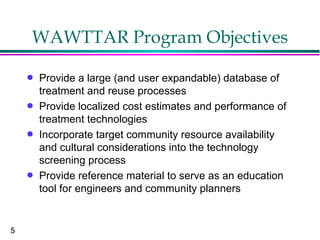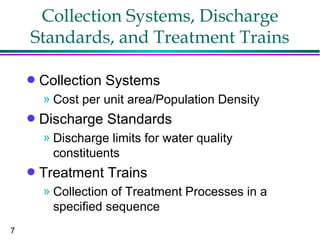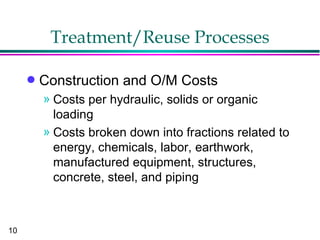WAWWTAR
- 1. WAWTTAR Water and Wastewater Treatment Technologies Appropriate for Reuse A Tool for Planning Water and Wastewater Treatment Facilities Appropriate for Reuse Brad A. Finney and Robert Gearheart Humboldt State University 1
- 2. Conventional Wastewater and Reuse Feasibility Planning Facility Planning for Wastewater Treatment Treated Wastewater Discharge (Viewed as a Liability) Treated Wastewater (Viewed as an Asset) Reuse Planning for Urban, Industrial, or Agricultural Activities Ultimate Disposal 2
- 3. Integrated Wastewater Treatment and Reuse Feasibility Planning Reuse Opportunities (Specifies Wastewater Treatment Objectives) Wastewater Treatment Ultimate Disposal (May Constrain Reuse Opportunities) 3
- 4. WAWTTAR Overall Objective Provide a tool for feasibility analysis of q wastewater treatment technologies that » Focuses attention on the inherent value of treated wastewater effluent » Recognizes the reality that wastewater is reused » Identifies treatment technologies that are not appropriate for the target community 4
- 5. WAWTTAR Program Objectives Provide a large (and user expandable) database of q treatment and reuse processes Provide localized cost estimates and performance of q treatment technologies Incorporate target community resource availability q and cultural considerations into the technology screening process Provide reference material to serve as an education q tool for engineers and community planners 5
- 6. WAWTTAR Database Components Existing Components (but can be edited) q » Collection Systems » Discharge Standards » Treatment Trains » Treatment/Reuse Processes Problem Specific Component (user specified) q » Community Description 6
- 7. Collection Systems, Discharge Standards, and Treatment Trains Collection Systems q » Cost per unit area/Population Density Discharge Standards q » Discharge limits for water quality constituents Treatment Trains q » Collection of Treatment Processes in a specified sequence 7
- 8. Treatment/Reuse Processes Construction and O/M Resource Requirements q Construction and O/M Costs q Operational Requirements and Performance q Adaptability q Social, Economics, and Environmental Impacts q Reference Materials q 8
- 9. Treatment/Reuse Processes Construction and O/M Resource q Requirements » Human - numerous labor categories » Social/Cultural » Materials » Land area » Site constraints 9
- 10. Treatment/Reuse Processes Construction and O/M Costs q » Costs per hydraulic, solids or organic loading » Costs broken down into fractions related to energy, chemicals, labor, earthwork, manufactured equipment, structures, concrete, steel, and piping 10
- 11. Treatment/Reuse Processes Operational Requirements q » Limits on influent flow and quality Operational Performance q » Percent constituent removal Adaptability to q » upgrading » varying hydraulic loading » changes in influent quality 11
- 12. Treatment/Reuse Processes Potential Social, Economic and q Environmental Impacts Reference Information q » Text descriptions » Line drawings » Photos Seasonal Hydraulic Demand (Reuse q Processes Only) 12
- 13. Community Description Demographics - Population, Land Area, q and Per Capital Wastewater Generation » Current level and growth rate Economic Setting q » Planning period length » Inflation rate and capital recovery factor » Local cost (relative to US.) for each construction and O/M cost category 13
- 14. Community Description Localized cost based on equivalent 1992 » U.S. Construction Cost Index for each category in local setting Average Construction Cost Index 8000 7000 6000 5000 1992 - WAWTTAR base year for CCI 4000 3000 2000 1000 0 1935 1945 1955 1965 1975 1985 1995 2005 Year 14
- 15. Community Description Site Characteristics q Meteorological Characteristics q Resource Availability q » Human » Material Social/Cultural Considerations q 15
- 16. Search for Feasible Treatment Trains Process Resource Social/Cultural Reuse Quality Final Effluent Limitations Requirements Considerations Limitations Quality All Treatment Trains in Database Feasible Trains 16
- 17. Treatment Process Selection Considerations Selecting among feasible treatment q processes requires evaluating the characteristics and tradeoffs of each process Quantitative q » Capital costs, O/M costs, useful life, salvage value, land area requirements Qualitative q » Operational ease, reliability, ease of expansion, adaptability to reuse processes, esthetics 17
- 18. WAWTTAR Output List of infeasible treatment trains with limiting q component identified Feasible treatment trains ranked by minimum capital, q O/M, or total cost For each feasible treatment train q » Effluent concentrations user specified quality constituents » Solids production » Adaptability index » Land area requirements » Reuse area satisfied with and without storage reservoir » Potential environmental and cultural impacts 18
- 19. WAWTTAR Users Designed for q » Local engineers and planners (with wastewater training) doing community wastewater feasibility or facility planning (field use) » Government or NGO planners performing evaluations of consultant or donor proposals (office paper study) » Technical students, planners, government decision makers, and engineers (educational resource) 19
- 20. WAWTTAR Users Field applications q » Jamaica (semi rural setting) » Bulgaria (municipal/industrial setting) » West Bank and Gaza (municipal, and peri- urban setting) » Koror, Palau » La’ie, and Waialua - Hale’iwa, Oahu (rural Hawaiian communities) » Willits and Garberville, CA 20
- 21. WAWTTAR Availability WAWTTAR Website q http://firehole.humboldt.edu/wawttar » » Program and manual available for download » Opportunity to share info on new treatment processes 21





















